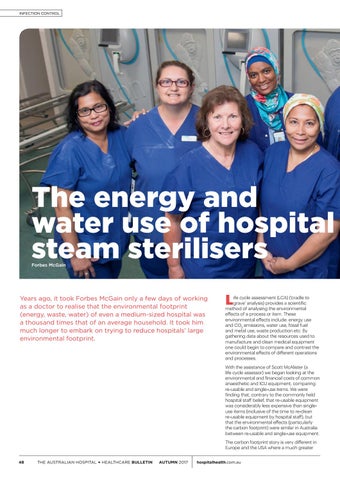INFECTION CONTROL
The energy and water use of hospital steam sterilisers Forbes McGain
Years ago, it took Forbes McGain only a few days of working as a doctor to realise that the environmental footprint (energy, waste, water) of even a medium-sized hospital was a thousand times that of an average household. It took him much longer to embark on trying to reduce hospitals’ large environmental footprint.
L
ife cycle assessment (LCA) (‘cradle to grave’ analysis) provides a scientific method of analysing the environmental effects of a process or item. These environmental effects include: energy use and CO2 emissions, water use, fossil fuel and metal use, waste production etc. By gathering data about the resources used to manufacture and clean medical equipment one could begin to compare and contrast the environmental effects of different operations and processes. With the assistance of Scott McAlister (a life cycle assessor) we began looking at the environmental and financial costs of common anaesthetic and ICU equipment, comparing re-usable and single-use items. We were finding that, contrary to the commonly held hospital staff belief, that re-usable equipment was considerably less expensive than singleuse items (inclusive of the time to re-clean re-usable equipment by hospital staff), but that the environmental effects (particularly the carbon footprint) were similar in Australia between re-usable and single-use equipment. The carbon footprint story is very different in Europe and the USA where a much greater
48
THE AUSTRALIAN HOSPITAL + HEALTHCARE BULLETIN
AUTUMN 2017
hospitalhealth.com.au
